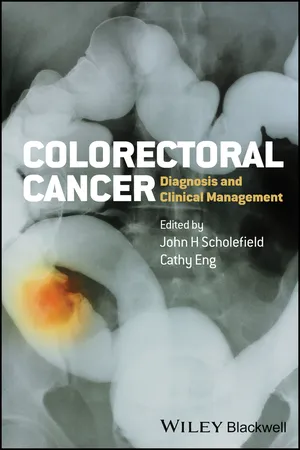
Colorectal Cancer
Diagnosis and Clinical Management
- English
- ePUB (mobile friendly)
- Available on iOS & Android
Colorectal Cancer
Diagnosis and Clinical Management
About this book
Colorectal Cancer: Diagnosis and Clinical Management provides colorectal surgeons, gastroenterologists and oncologists with an authoritative, practical guide to best practice in the diagnosis and clinical management of colorectal cancer.
Covering all forms of treatment including surgery, chemotherapy and radiotherapy, it examines the various new and emerging therapies, new strategies for screening and prevention, as well as the latest guidance on the most challenging and controversial aspects of managing colorectal cancer.
The authors present important information on:
- Controversies in adjuvant chemotherapy
- Long versus short course radiotherapy
- Minimally invasive surgery and robotics
- Radical colonic resection
Each chapter contains key points, tips and tricks and clinical case studies to aid rapid browsing and knowledge of the basic principles, while self-assessment questions allow readers to test their clinical knowledge.
With leading international surgeons, gastroenterologists and oncologists combining to offer their considerable wealth of expertise and knowledge, Colorectal Cancer is a well-balanced, indispensable resource for all those involved in colorectal cancer management.
Frequently asked questions
- Essential is ideal for learners and professionals who enjoy exploring a wide range of subjects. Access the Essential Library with 800,000+ trusted titles and best-sellers across business, personal growth, and the humanities. Includes unlimited reading time and Standard Read Aloud voice.
- Complete: Perfect for advanced learners and researchers needing full, unrestricted access. Unlock 1.4M+ books across hundreds of subjects, including academic and specialized titles. The Complete Plan also includes advanced features like Premium Read Aloud and Research Assistant.
Please note we cannot support devices running on iOS 13 and Android 7 or earlier. Learn more about using the app.
Information
PART 1
Diagnosis
CHAPTER 1
Epidemiology
KEY POINTS
- Ecological studies of populations are used to determine variation in rates. Incidence, mortality rate, time trends, and prevalence are some key measures.
- The burden of colorectal cancer varies globally: the incidence rate is 10 times higher and the mortality rate 5 times higher in countries with the highest rates than in countries with the lowest rates.
- Worldwide, colorectal cancer is the third most common cancer in men, the second most common cancer in women, and the fourth leading cause of cancer deaths.
- In the United States, colorectal cancer is the third most common cancer in both men and women (9% of the estimated incident cancer cases in both men and women in 2012) and the third leading cause of cancer deaths (9% of estimated cancer deaths in both men and women in 2012).
- There are geographic variations in incidence and mortality, with higher incidence but lower mortality rates in developed countries than in developing countries.
- Colorectal cancer incidence rates have been declining in the United States, and have been stable or declining in most developed countries but are rising in developing countries.
- The increasing risk of colorectal cancer in developing countries may be attributable to increased longevity, and adverse lifestyle changes including smoking, lack of physical activity, and adoption of a westernized diet.
- Colorectal cancer incidence and mortality rate vary by geographic location, age, sex, race/ethnicity, and over time.
- The prevalence of colorectal cancer is high because it has a relatively good prognosis. As a result, there are over 1 million colorectal cancer survivors in the United States.
- Cross-sectional, case-control, and cohort study designs can be used to determine the association of suspected environmental, lifestyle, and other exposures with colorectal cancer risk. Randomized controlled trials are the gold standard for determining cause and effect.
- Factors that increase the risk of colorectal cancer include older age, African-American race/ethnicity, inherited predisposition syndromes, family history of colorectal cancer or colorectal polyps, inflammatory bowel disease, personal history of colorectal cancer or polyps, diabetes, obesity, physical inactivity, smoking, and alcohol.
- Many other probable risk factors are under investigation.
Introduction
Colorectal cancer incidence worldwide

Colorectal cancer incidence, time trends, and lifetime risk in the United States (US)
Colorectal cancer mortality worldwide
Colorectal cancer mortality in the US
Table of contents
- Cover
- Contents
- Title Page
- Copyright
- Contributors
- Part 1: Diagnosis
- Part 2: Histopathology
- Part 3: Surgical
- Part 4: Oncology
- Part 5: Outcomes
- Part 6: Vignettes
- Index